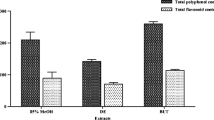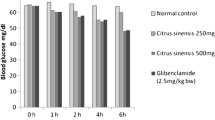Abstract
This study investigated the effect of fermented and non-fermented Pueraria thunbergiana extract (FPE and PE, respectively) on postprandial hyperglycemia in streptozotocin-induced diabetic mice. FPE was prepared by fermentation of P. thunbergiana with Bifidobacterium breve K-111 followed by methanol extraction. FPE’s inhibitory activity against α-glucosidase and α-amylase was significantly higher than that of PE with IC50 values of 0.15 and 0.10 and 0.23 and 0.44 mg/mL for FPE and PE, respectively. The increase in postprandial blood glucose levels was significantly higher in FPE- than in PE-treated diabetic mice. Furthermore, FPE significantly lowered the incremental area under the curve (AUC) in the diabetic mice; the AUC in the normal mice corroborated FPE’s hypoglycemic effect. The results from this study suggest that FPE, more than PE, may help decrease postprandial hyperglycemia by inhibiting α-glucosidase and a-amylase.
Similar content being viewed by others
References
Hirsch IB, McGill JB, Cryer PE, White PF. Perioperative management of surgical patients with diabetes mellitus. Anesthesiology 74: 346–359 (1991)
Grover JK, Vats V, Rathi SS. Anti-hyperglycemic effect of Eugenia jambolana and Tinospora cordifolia in experimental diabetes and their effects on key metabolic enzymes involved in carbohydrate metabolism. J. Ethnopharmacol. 73: 461–470 (2000)
Nishikawa T, Edelstein D, Du XL, Yamagishi S, Matsumura T, Kaneda Y, Yorek MA, Beebe D, Oates PJ, Hammes HP, Giardino I, Brownlee M. Normalizing mitochondrial superoxide production blocks three pathways of hyperglycaemic damage. Nature 404: 787–790 (2000)
Cavalot F, Pagliarino A, Valle M, Di Martino L, Bonomo K, Massucco P, Anfossi G, Trovati M. Postprandial blood glucose predicts cardiovascular events and all-cause mortality in type 2 diabetes in a 14-year follow-up: Lessons from the San Luigi Gonzaga Diabetes Study. Diabetes Care 34: 2237–2243 (2011)
Woerle HJ, Neumann C, Zschau S, Tenner S, Irsigler A, Schirra J, Gerich JE, Göke B. Impact of fasting and postprandial glycemia on overall glycemic control in type 2 diabetes Importance of postprandial glycemia to achieve target HbA1c levels. Diabetes Res. Clin. Pr. 77: 280–285 (2007)
Bhandari MR, Jong-Anurakkun N, Hong G, Kawabata J. α-Glucosidase and α-amylase inhibitory activities of Nepalese medicinal herb Pakhanbhed (Bergeniaciliata, Haw.). Food Chem. 106: 247–252 (2008)
Lebovitz HE. Treating hyperglycemia in type 2 diabetes: New goals and strategies. Cleve. Clin. J. Med. 69: 809–820 (2002)
Carroll MF, Gutierrez A, Castro M, Tsewang D, Schade DS. Targeting postprandial hyperglycemia: A comparative study of insulinotropic agents in type 2 diabetes. J. Clin. Endocrinol. Metab. 88: 5248–5254 (2003)
Fonseca V. Clinical significance of targeting postprandial and fasting hyperglycemia in managing type 2 diabetes mellitus. Curr. Med. Res. Opin. 19: 635–641 (2003)
Li Y, Wen S, Kota BP, Peng G, Li GQ, Yamahara J, Roufogalis BD. Punicagranatum flower extract, a potent a-glucosidase inhibitor, improves postprandial hyperglycemia in Zucker diabetic fatty rats. J. Ethnopharmacol. 99: 239–244 (2005)
Matsui T, Tanaka T, Tamura S, Toshima A, Miyata Y, Tanaka K, Matsumoto K. a-Glucosidase inhibitory profile of catechins and theaflavins. J. Agr. Food Chem. 55: 99–105 (2007)
Wang X, Wu J, Chiba H, Umegaki K, Yamada K, Ishimi Y. Puerariae radix prevents bone loss in ovariectomized mice. J. Bone Miner. Metab. 21: 268–275 (2003)
Keung WM, Vallee BL. Kudzu root: An ancient Chinese source of modern antidipsotropic agents. Phytochemistry 47: 499–506 (1998)
Park WS, Kwon O, Yoon TJ, Chung JH. Anti-graying effect of the extract of Pueraria thunbergiana via upregulation of cAMP/MITF-M signaling pathway. J. Dermatol. Sci. 75: 153–155 (2014)
Kim IT, Park YM, Shin KM, Ha J, Choi J, Jung HJ, Park HJ, Lee KT. Antiinflammatory and anti-nociceptive effects of the extract from Kalopanax pictus, Pueraria thunbergiana and Rhus verniciflua. J. Ethnopharmacol. 94: 165–73 (2004)
Park JH, Lee YH, Cho JK, Lee CH. Effects of puerariae radix root water extracts on the antioxidative activity in rats. Korean J. Food Sci. Ani. Resour. 19: 65–71 (1999)
Prasain JK, Jones K, Kirk M, Wilson L, Smith-Johnson M, Weaver C, Barnes SJ. Profiling and quantification of isoflavonoids in kudzu dietary supplements by high-performance liquid chromatography and electrospray ionization tandem mass spectrometry. J. Agr. Food Chem. 51: 4213–4218 (2003)
Kim DH, Yu KU, Bae EA, Han MJ. Metabolism of puerarin and daidzinbyhuman intestinal bacteria and their relation to in vitro cytotoxicity. Biol. Pharm. Bull. 21: 628–630 (1998)
Watanabe J, Kawabata J, Kurihara H, Niki R. Isolation and identification of alpha-glucosidase inhibitors from tochucha (Eucommiaulmoides). Biosci. Biotech. Bioch. 61: 177–178 (1997)
Kim JS. Effect of Rhemanniae radix on the hyperglycemic mice induced with streptozotocin. J. Korean Soc. Food Sci. Nutr. 33: 1133–1138 (2004)
Lebovitz HE. Postprandial hyperglycaemic state: Importance and consequences. Diabetes Res. Clin. Pract. 40: 27–28 (1998)
Gerish JE. Clinical significance, pathogenesis, and management of postprandial hyperglycemia. Arch. Intern. Med. 163: 1306–1316 (2003)
Hara Y, Honda M. The importance of hyperglycemia in the nonfasting state to the development of cardiovascular disease. Endocr. Rev. 19: 583–592 (1998)
Jin JS, Nishihata T, Kakiuchi N, Hattori M. Biotransformation of C-glucosyl isoflavone puerarin to estrogenic (3S)-equol in co-culture of two human intestinal bacteria. Biol. Pharm. Bull. 31: 1621–1625 (2008)
Kim KY, Nam KA, Kurihara H, Kim SM. Potent a-glucosidase inhibitors purified from the red alga Grateloupia elliptica. Phytochemistry 69: 2820–2825 (2008)
Stern JL, Hagerman AE, Steinberg PD, Mason PK. Phlorotannins-protein interactions. J. Chem. Ecol. 22: 1877–1899 (1996)
Park MH, Ju JW, Park MJ, Han JS. Daidzein inhibits carbohydrate digestive enzymes in vitro and alleviates postprandial hyperglycemia in diabetic mice. Eur. J. Pharmacol. 712: 48–52 (2013)
Ceriello A, Davidson J, Hanefeld M, Leiter L, Monnier L, Owens D, Tajima N, Tuomilehto J. International Prandial Glucose Regulation Study Group. Postprandial hyperglycaemia and cardiovascular complications of diabetes: An update. Nutr. Metab. Cardiovasc. Dis. 16: 453–456 (2006)
Ratner RE. Controlling postprandial hyperglycemia. Am. J. Cardiol. 88: 26–31 (2001)
Verges BL. Dyslipidaemia in diabetes mellitus. Review of the main lipoprotein abnormalities and their consequences on the development of atherogenesis. Diabetes Metab. 25: 32–40 (1999)
Bastyr EJ, Stuart CA, Brodows RG, Schwartz S, Graf CJ, Zagar A, Robertson KE. Therapy focused on lowering postprandial glucose, not fasting glucose, may be superior for lowering HbA1c. IOEZ Study Group. Diabetes Care 23: 1236–1241 (2000)
Hanefeld M. The role of acarbose in the treatment of non-insulin-dependent diabetes mellitus. J. Diabetes Complicat. 12: 228–237 (1998)
Author information
Authors and Affiliations
Corresponding author
Rights and permissions
About this article
Cite this article
Park, MH., Kang, JH. & Han, JS. The hypoglycemic effect of fermented Pueraria thunbergiana extract in streptozotocin-induced diabetic mice. Food Sci Biotechnol 24, 2199–2203 (2015). https://doi.org/10.1007/s10068-015-0293-7
Received:
Revised:
Accepted:
Published:
Issue Date:
DOI: https://doi.org/10.1007/s10068-015-0293-7




